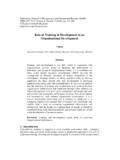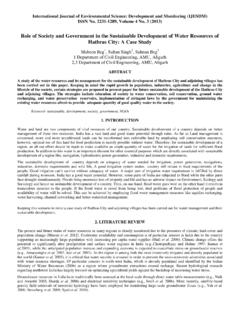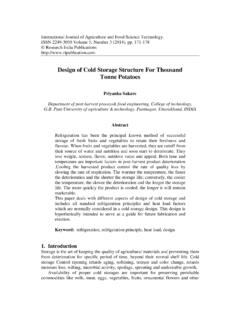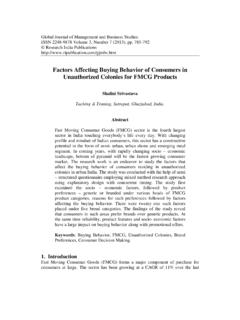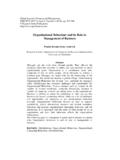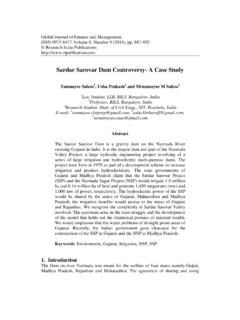Transcription of Foreign Direct Investment: Impact on Indian Economy
1 Global Journal of Business Management and Information Technology. ISSN 2278-3679 Volume 4, Number 1 (2014), pp. 17-23 Research India Publications Foreign Direct Investment: Impact on Indian Economy Bhavya Malhotra Sri Aurobindo College, University Of Delhi Abstract With the initiation of globalization, developing countries, particularly those in Asia, have been witnessing a immense surge of FDI inflows during the past two decades. Even though India has been a latecomer to the FDI scene compared to other East Asian countries, its considerable market potential and a liberalized policy regime has sustained its attraction as a favourable destination for Foreign investors.
2 This research paper aims to examine the Impact of FDI on the Indian Economy , particularly after two decades of economic reforms, and analyzes the challenges to position itself favourably in the global competition for FDI. The paper provides the major policy implications from this analysis, besides drawing attention on the complexities in interpreting FDI data in India. Objectives: The research paper covers the following objectives: To study the trends and pattern of flow of FDI.
3 To assess the determinants of FDI inflows. To evaluate the Impact of FDI on the Indian Economy . To know the flow of investment in India Introduction When a firm controls (or have a strong say in) another firm located abroad, by owing more than 10% of its equity, the former is said "parent enterprise" (or "investor") and the latter " Foreign affiliate". For a country, attracting an inflow of FDI strengthen the connection to world trade networks and finance its development path.
4 However, unilateral substantial FDI to a country can make it dependent on the external pressure that Foreign owners might exert on it. Foreign investment plays a significant role in development of Indian Economy . Many countries provide many incentives for attracting the Foreign Direct investment (FDI). Need of FDI depends on saving and investment rate in any country. Foreign Direct investment acts as a bridge to fulfill the gap between investment and saving. In the process of economic development Foreign capital helps to cover the domestic saving constraint and provide 18 Bhavya Malhotra access to the superior technology that promotes efficiency and productivity of the existing production capacity and generate new production opportunity.
5 Foreign Direct investment in India: FDI and Economic Growth The historical background of FDI in India can be traced back with the establishment of East India Company of Britain. British capital came to India during the colonial era of Britain in India. After Second World War, Japanese companies entered Indian market and enhanced their trade with India, yet remained the most dominant investor in India. Further, after Independence issues relating to Foreign capital, operations of MNCs, gained attention of the policy makers.
6 Keeping in mind the national interests the policy makers designed the FDI policy which aims FDI as a medium for acquiring advanced technology and to mobilize Foreign exchange resources. With time and as per economic and political regimes there have been changes in the FDI policy too. The industrial policy of 1965, allowed MNCs to venture through technical collaboration in India. Therefore, the government adopted a liberal attitude by allowing more frequent equity.
7 In the critical face of Indian Economy the government of India with the help of World Bank and IMF introduced the macro-economic stabilization and structural adjustment program. As a result of these reforms India open its door to FDI inflows and adopted a more liberal Foreign policy in order to restore the confidence of Foreign investors. Further, under the new Foreign investment policy Government of India constituted FIPB ( Foreign Investment Promotion Board) whose main function was to invite and facilitate Foreign investment Starting from a baseline of less than USD 1 billion in 1990, a recent UNCTAD survey projected India as the second most important FDI destination (after China) for transnational corporations during 2010-2012.
8 As per the data, the sectors which attracted higher inflows were services, telecommunication, construction activities and computer software and hardware. Mauritius, Singapore, the US and the UK were among the leading sources of FDI to the country. According to GYANPRATHA ACCMAN (Journal of Management, Volume 5 Issue 1, 2013) FDI for 2009-10 at US$ billion was lower by five per cent from US$ billion in the previous fiscal. Foreign Direct investment in August dipped by about 60 per cent to approx.
9 US$ 34 billion, the lowest in 2010 fiscal, industry department data released showed. In the first two months of 2010-11 fiscal. FDI inflow into India was at an all-time high of $ billion up 77%from $ billion during the corresponding period in the previous year. In 2013, the government relaxed FDI norms in several sectors, including telecom, defence, PSU oil refineries, power exchanges and stock exchanges, among others. In retail, UK-based Tesco submitted its application to initially invest US$ 110 million to start a supermarket chain in collaboration with Tata Group's Trent.
10 In civil aviation, Malaysia-based Air Asia and Singapore Airlines teamed up with Tata Group to launch two new airline services. Also, Abu Dhabi-based Etihad picked up a 24 per cent stake in Jet Airways that was worth over Rs 2, 000 crore (US$ million). Foreign Direct Investment: Impact on Indian Economy 19 India has received total Foreign investment of US$ billion since 2000 with 94 per cent of the amount coming during the last nine years.
